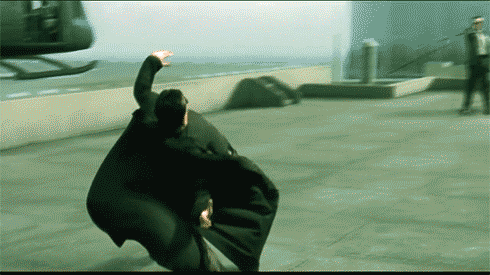Through Optical Effect
"Bullet Time" from The Matrix by the Wachowskis and John Gaeta
The protagonist (Neo) dodges bullets in his first display of super human reflexes relayed through an apparently impossible camera move.Logical Form - This is a performative function.
Illocution - Neo is more powerful than the other characters realized.
Perlocution - This scene generates a sense of awe and alignment of the audience with protagonist's supporting character; both are seeing something they would have said was impossible (in this case the audience is in wonder of how the director made that shot, and Trinity is amazed at how Neo managed to dodge the bullets).
Primitive - disorientation
Dolly-Zoom from Vertigo by Alfred Hitchcock and Irmin Roberts
Logical Form - This is a performative function.
Illocution - The protagonist is afraid of heights, and a long way from the ground.
Perlocution - The audience experiences a disorientation parallel with the protagonist's vertigo, aligning them with the protagonist.
Primitive - disorientation
- more on the dolly-zoom by a fairly well known editor (also mentions when one should use it)
Through Break with Cinematic Convention
Crossing the Line of Action from Paprika by Satoshi Kon
Satoshi Kon crosses the line of action (orients the camera on the opposite side of the axis connecting the characters (Levin 43)) at a moment in a dream sequence when the deuteragonist realizes something is wrong.
Logical Form - This is a performative function.
Illocution - There is something disturbing and wrong with the world the protagonist is in.
Perlocution - The audience is confused and frequently unsure if the events onscreen are a dream or reality in parallel with the deuteragonist.
Primitive - disorientation
- Kon, Satoshi. Interview by Jason Gray. Satoshi Kon. Midnight Eye. Midnight Eye, November 2006. Web. 09 November 2014. <http://www.midnighteye.com/interviews/satoshi-kon-2/>
- Levin, Melinda and Watkins, Fred P. Post: The Theory and Technique of Digital Nonlinear Motion Picture Editing. Boston: Allyn and Bacon, 2003. Print.
Through Spatial Orientation
"Paradoxical Floor Plan" from The Shining by Stanley KubrickLogical Form - This is a performative function.
Constative - The paradox is only discernible through a combination of shots of the Overlook Hotel. Individually most of them do not conflict and serve superficially inert utilitarian functions. The tricycle shot above shows room 237 switching sides and against a wall that could not have a room, but if you did not notice (and I did not the first time I saw it) the shot is telling the audience that the protagonist is scared of room 237.
Illocution - There is something disturbing and wrong with the world the protagonist is in.
Perlocution - A building psychological tension parallel with the protagonist
Primitive - disorientation
- (The idea of Kubrick's psychological use of a paradoxical floor plan came from Rob Ager's website, and it is refuted by John Aungst here. Though I thought Ager's evidence for Kubrick's deliberate spatial incongruence was compelling, and some of the goemetry is objectively impossible, Aungst's qualifications are much better (Ager has none beyond his site and YouTube fame, and Aungst is a well known screenwriter).




No comments:
Post a Comment